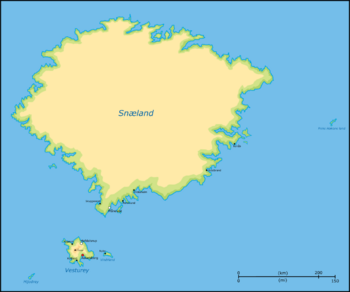Snæland
This article is incomplete because it is pending further input from participants, or it is a work-in-progress by one author. Please comment on this article's talk page to share your input, comments and questions. Note: To contribute to this article, you may need to seek help from the author(s) of this page. |
Snæland | |
|---|---|
Dependency of Norden | |
| Country | |
| Capital | Askelsborg |
| Government | |
| • Governor | Erik Lassen |
| Area | |
| • Total | 978,662.4 km2 (377,863.7 sq mi) |
| Population | |
| • Total | 148,513 |
| • Density | 0.152/km2 (0.39/sq mi) |
| Demonym | Snælander |
| Time zone | SST |
Snæland (Snælander: qaqortoqnunaat) is an autonomous dependent territory of the Nordic Kingdom located within the North Agric Ocean. The territory is composed of two islands, the eponymous island of Snæland as well as the island of Vesturey where much of the population resides. With a population of only 148,513 people and a land area of 978,662.4 km2 (377,863.7 sq mi), the territory has one of the lowest population densities in Aurorum at just 0.152 people per square kilometre (0.39/sq mi). This low population density is primarily the result of the territory's location which exists almost entirely within the Arctic Circle, at around 66° north of the equator. This location ensures much of the territory is inhospitable, with almost 90% of Snæland covered in a permanent blanket of snow and ice.
Inhabited since the bronze age by Inuit cultures of Alvinia, the islands of Snæland and Vesturey were discovered by Nordic explorer Ornulf Askelsson during the Tenth Century. Thereafter followed the establishment of overseas Nordic colonies and settlements at the behest of the King of Hamarland Halfdal II. Disconnected from Berea, many of these colonies did not survive, and those that did developed independently, establishing a trading relationship with the Inuit tribes with an economy primarily based on fishing and whaling. By the Fifteenth Century however, the Cuthish Empire asserted sovereignty over the area during its explorations of Alvinia, though this was disputed by the King of Vitmärige who claimed the region by right of his inheritance of Hamarland. The lands remained disputed between the two realms for centuries, with both Vitmärige and Cuthland establishing small settlements and trading posts within the region, however by the Seventeenth Century, Cuthish sovereignty prevailed. Yet, during the Partitions of Cuthland, Snæland and its surrounding islands were conquered by the newly formed Nordic Kingdom which instituted a program of widespread settler colonialism within the region, leading to considerable population growth and demographic shifts on the islands.

